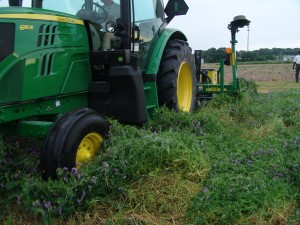As wheat progresses into jointing growth stages, one should be on the lookout for diseases in wheat. In particular, both stripe rust and leaf rust have been reported in Louisiana and Arkansas. Continue reading
Recent Updates
Corn Herbicide Premixes: PRE Emergence Applied Considerations
There is a new premix for corn being marketed in Tennessee. It is called Acuron. I have had several calls about it recently and have found that, like almost all the corn premixes, there is some confusion about what is in it. Continue reading
Times are tough-scrutinize every input choice
This article is by Gus Lorenz, Extension Entomologist with The University of Arkansas. It is good information for Tennessee producers.
Seems like most everybody who retails ag inputs is offering products that they profess will boost yields, even make ‘em skyrocket. Only problem is, claims often aren’t backed up with unbiased data to prove that these materials provide growers with a return on investment–that ROI that should guide every decision. Continue reading at Arkansas Row Crops Blog.
You need a change to uncover a profit
“What changes are you looking at in your operation for 2016?” If the 2014 and 2015 production years worked well, then maybe no changes are needed. If you struggled to pay all financial obligations or burned through capital reserves, then maybe a change is in order. Continue reading at Southeast Farm Press.
Herbicide Cut-Offs by Wheat Maturity
The wheat has really progressed well over the past two weeks. That short January cold snap had much of the wheat across the state looking very rough. However, since that time it has really come along well and looks to be in very good shape. Continue reading
Tennessee Market Highlights
Corn, cotton, soybeans, and wheat were up for the week. Projected spring crop insurance prices (volatility factors) for corn – $3.86/bu (0.17), soybeans – $8.85/bu (0.14), and cotton – $0.60/lb (0.14) were determined for Tennessee from February 1-29th. Compared to 2015, projected spring prices are down $0.29/bu, $0.04/lb, and $0.88/bu for corn, cotton, and soybeans, respective-ly. However, depending on an operation’s cost structure, crop insurance may be a better value for Tennessee corn producers this spring than last. Continue reading at Tennessee Market Highlights.
When should I terminate my cover crop?
As planting nears, people are beginning to decide how and when to terminate their cover crop. Cover crops are utilized for many reasons. However with respect to weed suppression, cover crops should be managed “crop specifically”, not unlike how we think of PRE herbicides. Factors that go into this decision will include cover crop specie(s), what the following crop is, and the size/stage of the cover crop.
UT Grain Newsletter 3/10/2016
Corn: Corn traded higher today due to better export figures in this week’s export report. Exports were helped by support from the wheat market and due to a lower dollar. Analysts are reporting that corn acres may be higher than what the USDA reported at the Outlook Forum last month. USDA has estimated that the 2016 crop will be about 90.0 million acres. The soil temperature in the Midwest is warmer than it has been the past few years due to a milder winter. Continue reading


